In this article written to commemorate World Radio Day observed on 13 February, Dr. M.C. Rasmin traces the history of Sri Lankan Public Radio and what could be done to make it more relevant to the changing demands and preferences of listeners today. It discusses some of the key challenges faced by a ‘public broadcaster’ in Sri Lanka, in an era of rapidly growing technology that demands constant changes and adaptation within the larger media ecosystem.
RADIO NOSTALGIA
It is certainly no surprise that Public Radio has survived almost 100 years in Sri Lanka. During these long years, it was locally and internationally known as a people’s medium, a rural medium (Timalsina and Pradhan 2019), an intimate medium (Barnard 2000), an adaptable medium (Fleming 2002), a sound medium (Crisell 1994), and a resilient medium (Starkey 2017). Moreover, it was identified as a speedy information and news disseminator (McLeish 1996) that can speak to millions (Coldevin 2003) at once.
Since regular broadcasting started in 1924, this Radio had played a significant role in shaping day-to-day life of millions of Sri Lankans. While the enactment of the Ceylon Broadcasting Corporation Act No. 37 of 1966 was detrimental to overall independent broadcasting, it created space for public interest broadcasting in Sri Lanka.
After Ceylon Broadcasting Corporation (CBS) became Sri Lanka Broadcasting Corporation (SLBC), in 1972, Radio played a significant role in enriching public life – nurturing local languages, literature (poetry, drama), folklore, culture, music, social life, and so on. Many of the renowned poets, musicians, lyricists, writers and novelists – both in Sinhala and Tamil – began their creative careers with SLBC.
The Education Service of SLBC was instrumental not only in offering exam-based formal educational programs, but also producing Non-Formal Education Programmes (NFEP), from 1994, dealing with a variety of subjects such as human rights, ethnicity, sociology, legal and medical issues, arts and culture, politics, current affairs, the environment, behavioral science, history, archaeology, literature, drama, women’s rights, etc.
Similarly, a specific time was allocated for religious broadcasting catering to Buddhists, Hindus, Christians and Muslims. Such programs were aired not only in Sinhala, English and Tamil, but also in other languages such as Malay, Urdu, etc. Several early programs and producers are still in the minds of listeners. Radio Ceylon and the SLBC produced some of the finest announcers and presenters in the world. Among them are Livy Wijemanne, Vernon Corea, Pearl Ondaatje, Greg Roskowski, Tim Horshington, Claude Selveratnam, Jimmy Bharucha, Thevis Guruge, Chitrananda Abeysekera, AW Dharmapala, Karunaratne Abeysekera, HM Gunasekera, SP Mylvaganam, VA Gaffoor, Nihal Bhareti, Leon Belleth, B.H. Abdul Hameed and Vijaya Corea. There could be many more.
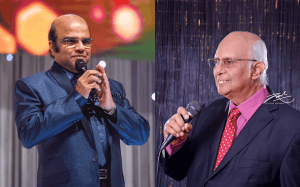 Vijaya Corea and B H Abdul Hameed, Veteran Broadcasters of SLBC
Vijaya Corea and B H Abdul Hameed, Veteran Broadcasters of SLBC
Broadcasters, such as V.A Gaffoor, were exceptionally talented as he could read Tamil news live, just by looking at the English news bulletin. BH Abdul Hameed became internationally popular as a Tamil broadcaster who travelled across the world presenting programs that had roots at SLBC and relevance to the latest trends. Former All India Radio broadcaster Sajan Venniyoor always used to say that several Indian broadcasters had deep nostalgia for Sri Lankan Radio given its remarkable programs. Colombo International Radio (CIR) and SLBC Asian Service were very popular with the Indian audience. These stations gained a huge popularity among the Indian listener. Indian commercials were broadcasted through these services. (Sinha, 2019).
The 30 years from 1960-1990 was the golden era of broadcasting. Millions of listeners tuned into the radio. Radio drama was one of the most popular programs aired in Sinhala and Tamil. “Muwanpalassa” – a Sinhala radio drama was widely known for representing the beauty of rural life. It was also known as the longest running Radio drama in the history of radio in Asia. Mudalinayaka Somaratne was the brainchild behind Muwanpalassa. Radio drama producers such as Shana (Shanmuganathan), George Chandrasekaran, M. H. Kuddoos, M. Ashroff khan, became very popular radio drama producers amongst several others for their remarkable story productions on various community issues. The dramas written and produced by M. Ashrofkhan became highly influential and popular in the Tamil – Muslim communities. He used radio drama as powerful medium to advocate gender equality, predominantly to highlight the educational rights of women.
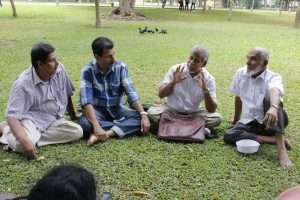 Ashroff Khan (Third from left), Veteran Radio Drama Producer of SLBC with fellow artists
Ashroff Khan (Third from left), Veteran Radio Drama Producer of SLBC with fellow artists
Broadcasting extended to farmers, fishers, and included all other segments through regional broadcasting in the early 1980s. SLBC Tamil service used comedy, storytelling and drama to create awareness of agricultural issues. R. Yogarajan, was very much known using comedy as medium in his radio storytelling to discuss various issues including agricultural development, education, etc.
It must be mentioned that these are accurate facts. Many studies have been carried out on these and several experts have documented this nostalgic journey of the state broadcaster. However, given the present state of SLBC broadcasting, one can only say that these are all just feel-good stories. Today SLBC is unable to comprehend contemporary trends and developments in broadcasting and thus sustain its audience or ensure its own marketability. Looking closely at SLBC’s current programs, they are found to be largely extensions of its initial formats.
CHALLENGES
At least five core issues could be identified among the many problems affecting the strength of SLBC. Firstly, after the 1990s, SLBC started severely compromising on its public mandates. At present the public broadcaster is an institution that is completely owned, administered and controlled by the state with ‘public money’, and is therefore a media that is largely incapable of upholding public interest or standing firm against the political interests of the state.
 SLBC Old Recording Studio
SLBC Old Recording Studio
Secondly, the state broadcaster is severely politicized. The interference of politics had already weakened the quality of SLBC programs and the entire institution as a whole. Due to lack of quality, SLBC is unable to demonstrate its marketability and reachability. Broadcasting experience and capacity to guide SLBC as a profitable entity hasn’t been entirely seen as a necessity when appointing members to its board. In the late 1980s, private stations in Sri Lanka started penetrating rural villages and from there on built their momentum. Several private radios followed the path of the state broadcaster, but they convinced and converted the loyal listeners of the state broadcaster into their charge.
Thirdly, SLBC has been unable to win the minds of the young audience and to accommodate their interests while formulating programs. While private channels target the younger generation, most of the commercial channels of SLBC still cater to the older generation even during prime time.
Fourthly, the state broadcaster is in urgent need to adapt to new technology so as to enhance its programs by understanding how radio should be positioned for convergence. SLBC introduced a mobile app. Most of its channels use social media to engage the audience. However, technology is hardly used to make programs with muti-media features and in multiple formats for different platforms. The concept of co-creation is not in existence. Audience engagement is often limited to requesting songs and writing micro-opinions.
Fifthly, for all these reasons, listening to SLBC frequencies has become a cumbersome experience, due to lack of clarity. SLBC needs urgent study and strategic revision for plotting a better way forward in this era of media convergence.
It is worth quoting from the study produced by the National Secretariate for Media Reform (2019):
“This was the time for SLBC to review its programming, social responsibility, management and fund-raising endeavors and introduce internal and external reforms. However, it failed to do so. Fully confident about itself and its acceptance in society, SLBC was unprepared to face the realities of the day. As a result, towards the end of the 1990’s SLBC saw its media workers migrate to privately owned radio and television stations which offered better wages, prospects and benefits. With funding issues and political interference, SLBC failed to come up with a productive plan to attract high quality media workers to it and the quality of its news and other programs, creativity and appeal took a hit (p. 33).
WHAT IS CONVERGENCE?
This article does not intend to discuss all the problems mentioned above, rather, it only tries to understand the fourth problem: how can the state broadcaster comprehend convergence and shape its business accordingly.
Convergence is the new buzzword in media research. In a technological sense, media convergence is all about integration and interoperability – the coming together of computing networks, information and communication technologies, together with digital forms of information that are inherently adaptable, delivered via ‘intelligent’ platforms, applications and devices (Holliman 2010).
In convergence different types of media – Print Media, Broadcast Media, New Media and the Internet – are delivered through a single digital platform but in multiple formats. In this context, where the state broadcaster is unable to prove its marketability, fulfill its public service mandate, or proactively cater to the rural population and younger generation, it is important to understand how traditional broadcasting could be re-visited. Presumably, in traditional broadcasting, convergence is involved at five different levels.
- Technological Level: This refers to a variety of digital tools available to enrich the production, programming, dissemination, audience engagement and evaluation of broadcasting. New and highly sophisticated tools have been introduced in the market to help audio visual storage, archiving, recording, editing, sharing, filming and other features. When it comes to programming, the technology makes it easy to host external live broadcasting, rural production, and storytelling which was a cumbersome process a decade ago. A technology-enabled radio production process is a shared exercise. In our time co-creation has become a revolution.
- Program Level: Convergence demands non-conventional programs that can attract the audience’s attention and captivate them emotionally and rationally, offering them a strong blend of information and entertainment. In a world where internet floods us with information, news and entertainment cheaply, with highest accessibility, radio cannot continue to offer such content in its older formats. Due to too much choice available on the internet, young listeners are spoilt for choice and know where to get what they specifically want. When broadcasting programs do not offer the anticipated substance, young people can easily shift to a different platform for less money. Some clever private stations have repurposed their contents digitally for different platforms or shared them visually in different formats. Convergence also demands that radio broadcasting highlights news, emerging issues such as local migration, climate change, health, education, agriculture, etc. Even older versions of broadcasting programs are required to be digital friendly too.
- Audience Level: Technology not only enriches the radio medium, but also empowers the audience. Radio listeners get an opportunity to migrate to online platforms and listen to radio through multiple devices. Most of the young audience spend a lot of time in cyber space. They find their own community there, even beyond physical boundaries and religious, faith, ethnic differences. Individuals have become not just listeners but content producers, disseminators, reporters, advocates, active-self-communicators, etc. Simply put, in the convergent environment audiences are not just listeners, they are active contributors.
- Contents and Distribution Level: Radio is no longer just an audio medium. It reaches the audience in several forms – pictures, video, graphics, cartoons, etc. A radio station produces its contents through radio, social media channels, and other new media platforms. At some point Radio was said to be a medium of ‘writing poems in the air’. This means, once something went up on radio, it’s just dead. However, today’s technology allows broadcasters to live forever; heavy programs files are saved in micro-chips and timely contents shared among larger networks.
- Platform Level: Radio in convergence offers a multi-platform experience. In convergence television, radio, social media, mobile phones, and the web are no longer separate and distinct media. They complement each other; they enrich each other, and they are interconnected through different pathways that ultimately lead to a larger pool of information. Therefore, it is time for traditional broadcasters to think differently while formatting their programs for multiple platforms.
WHAT DOES CONVERGENCE MEAN TO RADIO?
Convergence requires the broadcasters to believe in ‘technology’, amalgamation of ‘platforms and potential of the ‘young audience’ to take the radio to the rural population. Broadcasting should be taken to the villages and people should be kept in the loop. Multi-media proficiency is vital for broadcasters to ensure that the radio reaches the audience through different platforms other than just the radio. Broadcasters should engage the audience to co-create content. In France, Emilie Mazoyer, host of a youth-oriented programme co-created a music playlist, Tweet-Liste, together with her listeners and followers on Twitter, in 2011. When and if the space is given, the audience can produce content through Facebook, Twitter, Instagram, WhatsApp, Signal, Telegram etc. This will, on one hand, sustain the audience, and on the other, extend the ownership of radio to rural folk.
Convergence requires that radio programs be delivered in more than one format and form. It must be kept in mind that listeners do not have to rely on radio for entertainment, songs and cinema, etc., as they did in the past. With this reality in place, Radio can no longer just be a medium for songs. SLBC has a remarkable history on rural production, and catering for farmers. For the last one-year farmers in Sri Lanka have been facing a lethal situation without even an adequate harvest due to various practical challenges. The voice of farmers are often not adequately represented on radio, despite them being the larger segment of the audience. Technology in Radio should be made available to not only discuss the issues faced by farmers but also to discuss potential solutions for their crisis.
SLBC broadcasting is accessible through a mobile app. Listeners can request their songs through social media. Some social media is used to generate public opinions. However, SLBC social media often works as though it is within a time bubble – it’s the same loyal audience that stays there forever. Use of both new media and social media should elevate listeners from ‘listeners’ to ‘contributors’ and ‘owners’ of the radio. While the FM or digital radio audience, measured through traditional audience rating systems, constitutes the economic capital of the station, the social media audience represents its true social capital – one that is very ‘tangible’ and visible. (Tiziano Bonini, 2020). Very simple tools such as Survey Monkey or Google Forms can be used for collecting feedback and opinions. In addition, Poll Everywhere, Slido.com, mentimeter.com can be used to play games with audience through stations website or social media page.
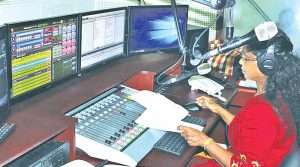 SLBC New Recording Studio (Photo courtesy, Dailynews.lk)
SLBC New Recording Studio (Photo courtesy, Dailynews.lk)
Broadcasting should no longer wait for the presenter to deliver content on request. Broadcasting contents and programs should be digitally available on the web platform for consumption at any time for individuals. The SLBC library has a wealth of resources that can be made available digitally. SLBC’s continuity studio should work as a multi-media delivery point. Audience should be able to connect through visual means.
Previously Radio broadcasting was presenter-centered. However, now it should become audience- and technology-centered. The audience should have a clear space to decide what they want. There are hundreds of creative pool-tools to identify what the listeners would need. Previously Radio possessed some kind of power – all the productions were made in-house; broadcasting was done by a privileged segment. Earlier the assumption was that audience can only listen to radio programs. However, the best broadcasting company in the convergence should be able to empower its audience as broadcasters, producers, contributors, and virtually invite them to feel ownership and discover their potential.
Finally, it is clear that the colorless medium incorporates various interactive and visual materials. This does not mean technology has started killing the older radio, rather, the older medium is expected to transform its nature in this new environment. Convergence has forced the radio to survive in a competitive news and information ecosystem. According to the study done by International Media Support (2020) Radio in Sri Lankan still remains the second most popular media for news –55% of the people consume news, during turbulent times. So, Radio needs to transform into a multimedia tool.
References
Barnard S. 2000. Studying Radio. London: Arnold.
Crisell A. 1994. Understanding Radio. London: Routledge.
Fleming C. 2002. The Radio Handbook. London: Routledge.
Gunawardena, N. 2020. Consuming News in Turbulent Times: Sri Lanka Media Audience Study 2019. International Media Support: Sri Lanka
Holliman R. 2010. Media convergence. In Encyclopedia of science and technology communication (Priest S, ed.). Newbury Park, CA: SAGE.
National Secretariate for Media Reform. 2019. Upholding public mandate: An analysis on state media in Sri Lanka. Colombo: NSMR.
Sinha, S. 2019. Radio Broadcasting in India and its Role in Social Development. Suraj Punj Journal for Multidisciplinary Research. Volume 9, Issue 4.
Starkey G. 2017. Radio: The resilient medium in today’s increasingly diverse multiplatform media environment. Convergence 23(6):660-670. https://doi.org/10.1177/1354856516673354
Timalsina M and Pradhan P. 2019. Role of local/community radio on rural development. Nepalese Journal of Development and Rural Studies Vol. 16. DOI: https://doi.org/10.3126/njdrs.v16i0.31570.
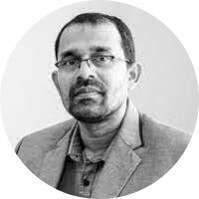 Dr. MC Rasmin is a Senior Lecturer attached to SLTC Research University, Sri Lanka, and Heading the Department of Digital Journalism. Previously he was Deputy Chief of Party and Senior Partnership Director of IREX, and CEO of Sri Lanka Development Journalist Forum. Rasmin has more than 15 years of experience in radio broadcasting and radio drama production. (mcrazmin@gmail.com).
Dr. MC Rasmin is a Senior Lecturer attached to SLTC Research University, Sri Lanka, and Heading the Department of Digital Journalism. Previously he was Deputy Chief of Party and Senior Partnership Director of IREX, and CEO of Sri Lanka Development Journalist Forum. Rasmin has more than 15 years of experience in radio broadcasting and radio drama production. (mcrazmin@gmail.com).




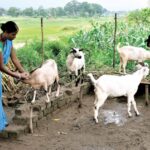




Well written on Sri Lankan Radio, history, developments, challenges and ways and means to make it much more useful in future. Good read for all the concerned. Congratulations.
“The challenges narrated by the author holds good for All India Radio stations also. But I feel that SLBC like All India Radio has the credibility among the audience as it is govt. controlled. I think this factor need to be exploited by focusing on broadcasting reliable information in a situation where the audience are flooded with information and that too with lot of fake news.
It is becoming increasingly difficult for the radio to compete with other mass media channels. Without technological edge it is not that easy for the radio stations to survive. As the author pointed out the radio must re-invent itself to increasingly make it audience and technology centred which requires lot of creativity and funding from the Government.
I still remember my school days when the SLBC was famous for its BINACA GEETMALA Hindi songs programme . We used to catch this radio from nook and corner of Andhra Pradesh probably because of the powerful transmitter. In addition it was presenter oriented. I can still recollect the presenter …Ameen Sayani.. Such is the influence of SLBC on people like me.
Congratulations to the author Dr. M.C.Rasmin and thanks to AESA”
This is a great write up explaining how radio needs convergence to transform itself to continue to be relevant for its audience which expects to connect with it in many different ways. Truly said, Radio broadcasting has been presenter- centered since long. However, now it should become audience- and technology- centered. The audience should have choices to decide what they want out of the hundreds of creative pool-tools to identify what they as listeners would need. Very well said, the best broadcasting company in the convergence should be able to empower its audience as broadcasters, producers, contributors, and virtually invite them to feel ownership and discover their potential. Congratulations, and thank you Dr Rasmin for sharing your experience based practical ideas which can improve radio broadcasting in many countries across the world. On personal note, this post made me nostalgic of Radio Ceylon, which was very popular in India till 1988. We would never miss
Binaca Geetmala, a weekly countdown show of top filmi songs from Hindi cinema, anchored by Ameen Sayani having millions of listeners. Binaca Geetmala was broadcast on Radio Ceylon from 1952 to 1988 and then shifted to the Vividh Bharati Service of All India Radio network in 1989 where it ran until 1994. It was the first radio countdown show of Indian film songs, and has been quoted as being the most popular radio program in India during its run. Thanks to AESA for making efforts to bring experiences from the region. It would be good if professionals from other countries in the region share their views too, particularly when World Radio Day is on 13th February.